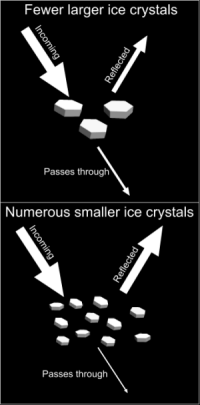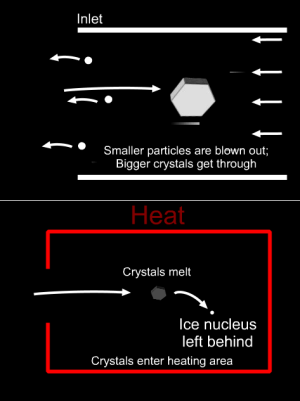Cloud Physics Research - Formation of Ice Crystals
by Dr. Christopher Emersic

Work is underway at the moment in the Manchester Ice Cloud Chamber to examine ice crystal formation in clouds. There are a number of ways in which ice crystals can form in clouds at temperatures lower than 0°C; one method involves the relatively rare presence of a particle known as an ice nucleus within a water droplet which acts as a catalyst for freezing. A liquid water droplet that has frozen to solid ice in this way is said to have nucleated, and when caused at a temperature between 0–-36°C in this way, is more specifically called heterogeneous nucleation. Examples of such nucleating centres include dust, minerals, black carbon and certain biological material, such as leaf litter, lichens and bacteria (e.g. pseudomonas strains). Biological sources are able to form ice crystals at perhaps the highest temperatures.

Homogeneous nucleation, in contrast, is a term used when water unavoidably and automatically freezes, without the presence of ice nuclei or other external influence, at temperatures below around -36°C, and occurs as a natural consequence of the microscopic, thermodynamic properties of water at that temperature (Fig. 1). This is the true freezing temperature of pure water, but in everyday-land, pure water is rarely encountered, and water often contains some form of ice nuclei and thus freezes at around 0°C (in our ice-cube trays for example). If it doesn’t freeze, it is said to be supercooled. In nature, supercooled water can lead to ice storms in which the sub-zero rain drops only freeze when they reach and ground and touch something, leading to ice accumulations and possible damage to the environment and property. Lots of video clips of the heterogeneous freezing of supercooled water can be found on YouTube playlists. Ice storm videos can be found here; Oklahoma, USA 2007 ice storm videos (in which the website author was present) can be found here. The formation of ice under heterogeneous conditions is the focus of study here.
An understanding of the role of ice in the atmosphere is important for studies of climate change. Climate models have shown that the effects of ice are uncertain and have a potentially significant effect on the radiation budget and thus temperature change of the planet (Iacobelis et al. 2003). This was determined by running the climate models (simulating many years into the future) with default settings, and then run again but with the CO2 presence doubled. Then these two runs are repeated but with a change in one of many other environmental parameters—such as the amount of ice present in the atmosphere. Many such analyses have been run and it has been shown that the microphysical parameter with the largest uncertainty and potential for biggest effect is the ice crystal fall speed inside clouds (Mitchell et al. 2008; Sanderson et al. 2008). This in turn is affected by all related microphysical parameters which could affect it, such as ice crystal number and size, available water vapour for growth etc. In situations where ice crystal fall speed is low and ice remains for longer in the upper atmosphere, the humidity (amount of water vapour) in that region is increased. The increased water vapour presence can affect the radiation budget of the planet, and for example, act like a blanket for long-wave radiation being emitted by the Earth and help trap heat. More information about the fall speed of ice crystals can be found in the ice crystal fall speed section.
The scattering properties of incoming solar radiation are also affected by the number and size of ice crystals present in upper-level ice clouds (see scattering section for more details about light scattering by ice crystals). If the available water content is in the form of many more smaller crystals than fewer larger crystals, the total effective reflective surface area of the cloud increases causing less incoming solar radiation to reach the surface, and this aids in cooling (Fig. 2). This high ice crystal number situation can arise if there is lots of ice nucleation, i.e. there are lots of ice nuclei present in the atmosphere, or nuclei of a type that are very efficient at causing nucleation.

In the laboratory studies, we intend to inject a range of ice nuclei into the chamber and examine the number of ice crystals produced under given environmental conditions. Ice particles in real clouds are collected through an inlet on the wing of a research aircraft, and these measurements are used to determine the types of ice nuclei present. As the aircraft and onboard probes travel through the clouds at high speed, a counter air flow is passed through the probe inlet such that only the particles with the greatest inertia make it through (Fig. 3). This will most likely be ice crystals. These ice crystals are then evaporated and their remaining contents collected for analysis. The contents will likely contain the nucleus which caused the original water droplet to freeze. More of these nuclei will then be used in the chamber to simulate the observed natural conditions. We will likely be generating cloud using an expansion of the chamber air to promote cooling and liquid cloud formation. At lower temperatures with the ice nuclei present, the droplets will likely nucleate and form ice crystals. As the ice crystals fall to the bottom of the chamber, they will be sampled with the Cloud Particle Imager for later analysis. The Welas aerosol probe will also be able to measure ice nuclei concentrations being introduced to the chamber. We hope to be able to identify relationships between ice crystal concentration and the specific ice nuclei used to determine which nuclei are the most efficient at nucleation.
References:
Iacobelis, S. F., G. M. McFarquhar, D. Mitchell, and R. C. J. Somerville, 2003: The sensitivity of radiative fluxes to parameterised cloud microphysics. J. Climate, 16(18), 2979–2996.
Mitchell, D., P. Rasch, D. Ivanova, G. M. McFarquhar, and T. Nousiainen, 2008: Impact of small ice crystal assumptions on ice sedimentation rates in cirrus clouds and gcm simulations. Geophys. Res. Lett., 35(doi:10.1029/2008GL033552), L09,806.
Sanderson, B. M., C. Piani, W. J. Ingram, D. A. Stone, and M. R. Allen, 2008: Towards constraining climate sensitivity by linear analysis of feedback patterns in thousands of perturbed-physics gcm simulations. Clim. Dyn., 30, 175–190.